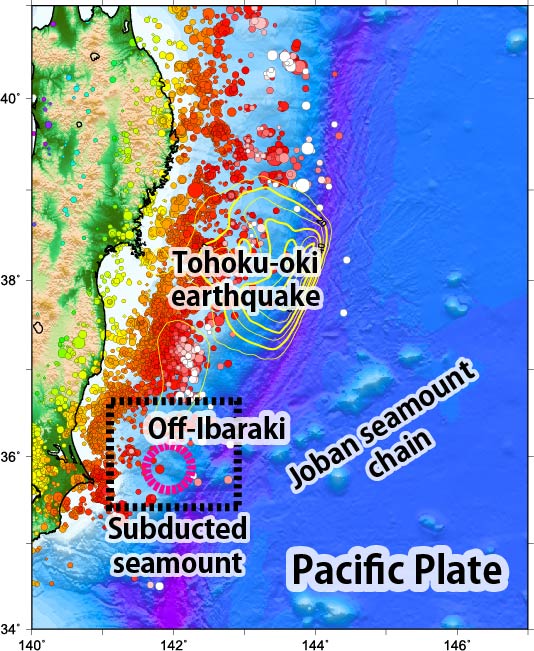Kimihiro Mochizuki
Marine Seismology @ ERI, U-Tokyo
Japan Trench off Ibaraki Pref.
(Southern boundary of Tohoku-oki EQ focal area)

The Pacific plate is subducting west-northwestward along the Japan Trench at a rate of about 10 cm/year, and plate interface earthquakes are especially active north of 37°N. Offshore Ibaraki Prefecture around 36°N latitude is the southern boundary of the focal region of the 2011 off the Pacific coast of Tohoku earthquake (the Tohoku-oki earthquake), as well as the site of magnitude 7 class large earthquakes that occur almost regularly every 20 years. The Joban seamount chain exists on the seaward side of the trench axis, and the subducted seamounts are thought to affect seismic activity.

Mochizuki, K., Y. Yamada, M. Shinohara, Y. Yamanaka and T. Kanazawa, Weak Interplate Coupling by Seamounts and Repeating M ~ 7 Earthquakes, Science, DOI:10.1126/science.1160250, 2008
Tectonics off Ibaraki Prefecture and offshore active source seismic survey and seismic observation
On the Japan Trench axis at 35°45' N latitude, the Dai-ichi Kashima Seamount has begun to subduct. On the landward slope of the trench axis, there are depressions on the seafloor that are thought to have formed after the subduction of a seamount in the past (arrow in the figure). The yellow star in the figure indicates the epicenter of the 1982 Ibaraki Prefecture Offshore Earthquake, one of the repeating large earthquakes with a 20-year cycle, and the green area around it indicates the area of aftershock activity. Since these topographic features and areas of seismic activity are parallel to the direction of subduction of the Pacific plate, it is expected that the subduction of seamounts is involved in the occurrence of large earthquakes with a 20-year cycle.
In order to understand the causes of these repeated large earthquakes, we conducted, in 2004, an active source seismic survey along two crossing profiles (whilte lines in the figure) using ocean bottom seismometers (white circle), and in 2005, another survey along the orange profiles and three months of seismic observations.
Seamount subduction and seismicity
An active source seismic survey confirmed a subducted seamount as large as Mt.Fuji along the plate interface at a depth of 10 km. However, its location was outside the focal region and aftershock activity of the 1982 earthquake to the south, and its epicenter was located at the bottom of the seamount. The seismic activity on the seamount is low, and it is pointed out that the aseismic belt to the north of the identified seamount (blue region) can be traces of seamount subduction in the past.
